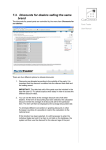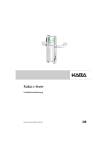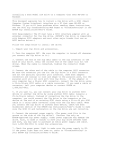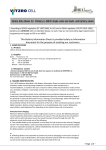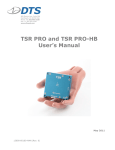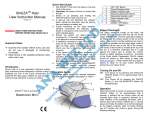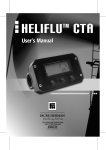Download Honeywell Trendview V5 Replacement/Upgrade Instructions, 43
Transcript
Installation Instructions: 100mm “Key” Recorder Battery Replacement Kit Ez 3.6V Battery Kit number L005201010/S Battery Function With the battery switched on and the recorder power off, the battery will last 6/8 months, with the battery and recorder power on, the battery should last for up to 10 years. The battery “backs-up” the setup, the realtime clock and any data not stored to disk. If the battery becomes exhausted the realtime clock, setups and any data will be lost in a power down situation. NOTICE BEWARE LOSS OF INFORMATION The realtime clock, setups, and any data will be lost if the battery is exhausted and the recorder is powered down. Ensure all setups, data and layouts are saved. Battery Replacement Recorders built before July 2002 have an internal battery that is soldered in place and is not easily replaceable. If you have a recorder with an internal battery fitted the recorder must be returned to your supplier for replacement. For recorders built after July 2002, it is not necessary to remove the rear panel to replace the battery. Removing the case and opening the back of the recorder should only be performed under the following circumstances: • When an item of hardware requires individual replacement. • When an item of hardware is to be retrospectively fitted. In all other instances it is recommended that the complete unit be returned for service to an authorised agent or service centre. Before attempting any maintenance on a recorder, it is advisable to clear a sufficient work space so components such as the front panel can be rested on the work surface without getting scratched or damaged. CAUTION BATTERY FITTING PRECAUTIONS This battery must be replaced by an ‘experienced technician’. Failure to comply with these instructions may result in product damage. 43-TV-33-42 GLO Issue 2 03/04 UK 1 WARNING HAZARDOUS VOLTAGES Disconnect all power to the recorder before removing the case and attempting any maintenance procedures. SAFETY TESTS Upon completion of service procedures detailed in this manual two basic safety tests should be performed in order to ensure continued safe operation of the instrument. 1. Earth Resistance; 25 Adc applied between case and protective earth, bonding resistance should be < 0.1 Ohm. 2. Insulation Resistance; 500Vdc applied between the earth terminal, and the live and neutral terminal shorted together, insulation resistance to be >2.0 MOhm. (Mega Ohm, NOT milli Ohm) Failure to comply with these instructions could result in death or serious injury CAUTION OBSERVE ANTI-STATIC PRECAUTIONS Refer to BS EN1000151:1992. Basic specification. Protection of electrostatic sensitive devices. Full anti-static precautions MUST be observed when in contact with the electronics of your recorder. SAVE DATA & SETUPS Removal of PCBs and battery back-up will result in the loss of all non-volatile data. Ensure all set-ups, data and layouts are saved. Failure to comply with these instructions may result in product damage. Figure 1. Rear view showing battery holder Battery holder Battery to be fitted with the positive (+) end outermost. 2 43-TV-33-42 GLO Issue 2 03/04 UK Battery Fitting It is advisable to replace the battery when the recorder is powered down, however this is not essential. It is important to observe antistatic precautions and hazardous voltage levels, being aware of wires carrying voltage within the recorder if the power is still on. The battery holder is located on the rear of the recorder, it has a circular plastic cover that has a “push and twist” method of fitting and removal. See Figure 1 on page 2. The battery will pop up as soon as the cover is removed. To fit the battery, there is a “+” positive sign stamped on the inside of the battery cover. This is to indicate correct orientation when inserting the battery. The positive end of the battery should be pointing outermost for connection with the inside of the cover. See Figure 1 on page 2. Drop the new battery into the slot, place the cover on top and pus down to locate with the slots in the unit. Twist the cover a 1/4 turn to secure. WARNING HAZARDOUS VOLTAGE LEVELS Voltage levels above 30V rms and 42.4V peak or 60V dc are deemed to be ‘Hazardous Live’. Refer to ’Battery Data ’on page 3 for further information. Failure to comply with these instructions could result in death or serious inju CAUTION BATTERY FITTING PRECAUTIONS This battery must be replaced by an ‘experienced technician’. Failure to comply with these instructions may result in product damage. NOTICE This battery is not a standard 1.5V AA cell. Refer to ’Battery Data ’on page 3 for recommended manufacturers. Battery Data NOTICE Handling Precautions The material in this section may only represent a hazard if the integrity of the battery is compromised, or if the battery is physically or electrically abused. For replaceable batteries fitted in recorders from July 2002. For recorders built before July 2002 refer to the User manual. 43-TV-33-42 GLO Issue 2 03/04 UK 3 Identification Recommended manufacturer: • 3.6V Tadiran Electronic TL5104, USA. (order number - batteries x 5 L005201010/S). Type Inorganic Lithium Battery SL360/S Typical Capacity (mAh) 2300 mAh Weight (g) 18g Chemical System Li/SoCl2 Voltage 3.6V Chemistry System Lithium Thionyl Chloride Anode Lithium metal Cathode Liquid, Thionyl Chloride Composition/Information on Ingredients NOTICE Handling Precautions The material in this section may only represent a hazard if the integrity of the battery is compromised, or if the battery is physically or electrically abused. CAS No, Approx. percent of total weight Hazard symbol R-phrases Lithium metal 7439--93-2 2- 6 F, C 14/15-34 Thionyl Chloride 7719-09-7 18 - 47 C 14-34-37 Aluminium Chloride 7446-7--0 2-5 Lithium Chloride 7447-41-8 1-2 Carbon 7440-44-0 2-5 Steel, Nickel plated - 35 - 73 Glass - 0-2 PVC 9002-86-2 0-1 PMMA 9011-14-7 0-1 PTFE 9002-84-0 0-1 Substance Hazard Identification and Disposal considerations WARNING HAZARDOUS CONTENTS • Fire, explosion and severe burn hazard. Do not recharge, disassemble, heat above 100°C, incinerate, or expose contents to water. • Dispose by incineration or burial at permitted waste treatment and/or disposal sites. Failure to comply with these instructions could result in death or serious injury. 43-TV-33-42 GLO Issue 2 03/04 UK 4




